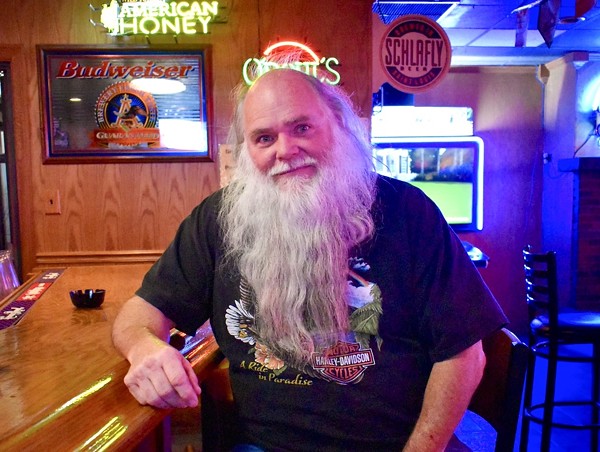Local News
St. Louis Wrestling Champ Moondog Rover Is Ready for His Triumphant Return | St. Louis Metro News | St. Louis

click to enlarge REUBEN HEMMER Moondog Rover, a.k.a. Paul McKnight, is a beloved figure at the South Broadway Athletic Club wrestling matches. He has not performed for six months due to a heart attack in July.
There is nothing quite like a night of wrestling at South Broadway Athletic Club (2301 South 7th Street, 314-776-4833, sbacstl.org). Since 1985, the Mid-Missouri Wrestling Alliance has organized match after jaw-dropping match within the historic south city institution, a location that has hosted boxing and wrestling tournaments in the Soulard area since 1899. Each and every second Saturday of the month, the building becomes an energetic melting pot, offering one of the most unique and entertaining cultural events one can experience in the City of St. Louis. Every walk of life attends, and nobody acts like a stranger. Two dollar draught beers flow like wine, and by the end of the night, your face hurts from smiling so much.For over 10 years I have been lucky enough to attend many matches at South Broadway Athletic Club, and one major consistency is the crowd voicing its opinion of the participating wrestlers. Children showcase homemade posters stating which wrestler they think “stinks,” and fearless wrestling fans lean in on the barricade to challenge the largest of competitors. However, it is no secret which wrestler the crowd absolutely adores. A wrestler who appears to be more animal than man, is said to be born from the darkest corner of the most putrid swamp, and utilizes an oversized bone as a weapon of mass destruction. The wrestler is Moondog Rover.With shaggy white hair and an untamed beard, Moondog gives off the appearance of an unhinged Santa Claus out for revenge. His sole means of communication is barking like a feral canine, and a derelict rope is the only thing holding up his frayed pants. click to enlarge REUBEN HEMMER Moondog Rover only uses a frayed rope to hold up his pants when he’s wrestling and is known for barking at opponents and fans.
Moondog is well known for hiking up his leg like man’s best friend to pretend to pee on kids shoes, and the maniac wrestler is not afraid to take a bite out of his opponents. To say the audience is charmed by Moondog’s antics would be an absolute understatement. The room echoes with fans barking like wild dogs every time he enters the ring, and chants of “Moondog” are heard throughout the night. These barks of admiration almost came to a tragic end in 2022 however, when 57 year old Paul McKnight — a.k.a. Moondog — suffered a heart attack following a wrestling match in mid-July. Thankfully, Moondog survived, but he was left with the real possibility of a fate worse than death in his own eyes: never being able to wrestle again.For the last six months, Moondog has been on the road to recovery, undergoing test after test at a cardiac rehab facility while awaiting clearance from doctors to wrestle again. I met Moondog at DuBowl Lanes (2711 Lemay Ferry Road, 314-892-3900, dubowllanes.net) in Lemay on his birthday to learn more about his near death experience, and to hear how wrestling has shaped his life. Normally, Moondog is associated with tearing into his adversaries while foaming at the mouth. During our discussion, he helped his mother arrange cupcakes while explaining his story in a soft, comforting voice — contrary to barking like a junkyard dog. Reuben Hemmer: So where are you from? What was your first experience with wrestling? Moondog Rover: I was born Paul McKnight on November 13, 1965, in Detroit, Michigan, however I grew up at my grandma’s house in Bradford, Tennessee. My first taste of wrestling began watching wrestlers like Jerry Lawler and Bill Dundee on TV. We moved around a lot [when I was] a kid, and wherever there was a local wrestling channel on TV, I watched it. Places like Ohio, Kentucky, Indiana, Tennessee — many of my biggest influences were wrestlers in the mid-south.My aunt Doris would take me along to live matches, and I really enjoyed watching wrestling with her any chance I got. Us kids would go to the matches early on Saturday morning, because a few of the organizers would pick us out of the crowd to help set up the ring. That was our free ticket in, and I was always the one in the crowd yelling, “Pick me! Pick me!” When we moved to Indiana, I started wrestling from eighth grade through high school, and that only increased my desire to pursue professional wrestling. Then my family moved to the St. Louis area in 1982, where I finished high school at Ritenour High. A guy I went to school with came up to me and said: “Hey do you still love wrestling? Go down to South Broadway Athletic Club this weekend and talk to [wrestler and promoter] Tony Costa.” I made my way down there, and I still don’t know what Tony saw in me, but he looked me up and down and said “We work out here on Mondays and Tuesdays.” That started in November of 1987, and I’ve been going ever since. Thirty-five years later I’m still at [Mid-Missouri Wrestling Alliance].RH: How did you become Moondog Rover? MR: I originally began wrestling under the name, “Crazy Paul,” and I found myself at a match in Tennessee where one of the original Moondog [collective] wrestlers, Moondog Spot, was performing. He approached me and asked if I had ever considered being a Moondog. I said, “No, I haven’t,” because I was really doing my own thing, but then I thought “Why not? We’ll see how far it goes, and let’s have some fun with it.” So I went ahead and became Moondog Rover. I started working with Moondog Spot at his shows in Osceola, Arkansas, and I was just having so much fun being Moondog. We found ourselves doing what they call “running the circuit.” Memphis Coliseum on Monday; Louisville Gardens on Tuesday; Tunica, Mississippi, on Wednesday; an off night on Thursday; Osceola, Arkansas, on Friday; Saturday morning TV and Saturday evening shows; and finally Sunday at The Gaylord in Nashville. I did that whole circuit for six or seven months while holding down a full-time job at a tractor-trailer company.RH: How was life on the road? MR: It was challenging with a full-time job, but I always looked at it as more experience. I work for a company called Dino’s Logistics, and when I was younger I would drive [long-haul]. If I knew I had a layover for the weekend, I would look up the local booker. I always brought my stuff with me, and I’d go to them and say: “Hey, you don’t have to pay me. I just want the experience,” and they’d put me in the show. I’ve met so many different people this way, it’s really been a dream. For instance, one match I faced [Dwayne] The Rock [Johnson]! Me and Moondog Spot took the title away from him and his partner. I even hit him over the head with my bone. It’s never been about the money, just the passion for the sport. click to enlarge REUBEN HEMMER Moondog Rover has been wrestling for 35 years and is known for hitting people with a bone.
RH: Sounds like that bone has hit many famous heads. I imagine being hit with an object by one of your heroes, or hitting them with your own, is a pretty big deal in the wrestling world. MR: The bone has hit quite a few. Oh yeah, some of my most memorable matches were against Jerry “the King” Lawler, “Superstar” Bill Dundee, “Handsome” Jimmy … matches against those veterans is something I’ll remember for the rest of my life. One of the last ones I did with Lawler was an outside show he put on at his barbecue place. It was misting rain and only 40 degrees. A lot of folks didn’t show up because of the weather, including the sound guys. The match still went on, but that vinyl ring was slick as all get out. So we just took all the matches outside of the ring and used his barbecue place as a prop! I hit his head on the side of the building, and we ended up getting into the fans. He grabbed a broom and smacked me with it. I was just really enjoying it all. RH: You can tell in your performances there is an old school charm. Nothing is really ever offensive, and the crowd really loves it. What are some of your favorite ways to get the crowd going? MR: Oh yeah I don’t cuss, that’s just how I learned. There’s a whole new generation that’s a little more fast paced and exciting than what I’m doing, but you gotta stick with the classics. In Louisville, Kentucky, there were these four women who were not paying attention to the show, sitting front row with their husbands right behind them. All of the pretty boy wrestlers were shaking their stuff at the gals, and these pretty boys were getting mad because the ladies weren’t paying any attention. So during my match, I got released from a chain link leash, and I popped a bunch of Alka-Seltzers to get the foam in my mouth going. I did a dead sprint right at them with all of that foam flying, barking my head off! Three of them actually got up and ran away, and the fourth couldn’t move because she was so scared. But that was the whole point! They sure watched me after that. RH: It’s an art form! MR: Exactly, I know critics say we choreograph and whatever — but the truth is I make stuff up as I go. It’s a good way to gauge the crowd, and see how they react to stuff. There’s times we’ll go to town, and I was supposed to be the good guy and they ended up hating me. OK then, so I’ll be the bad guy!RH: Has being the bad guy ever backfired? MR: Oh yeah. One time me and Moondog Spot were wrestling in some little town in northeast Arkansas, and we ended up getting a police escort out of the town. We tore up the opponents we were facing, a father-son team, and the father had a wife who was a wrestler as well. We threw her in the mix, throwing an ironing board at her, crutches, what have you. Turns out she was the mayor’s daughter! The mayor wasn’t too fond of our match, so the police escorted us out of town. There were like 300 to 400 people there, and it was all torches and pitchforks! Got our money back from the hotel at least. RH: Well it is no secret you are beloved at South Broadway Athletic Club. When did you realize you became a crowd favorite? MR: I think more or less when I got my name from Moondog Spot. After working with him in Tennessee, I came back up here to wrestle with Tony Costa at [Mid-Missouri Wrestling Alliance]. I more or less proved myself carrying that name, and the crowd started going ape for what I was doing. I think that was the turning point. I have all the wrestlers I worked with down south to thank for that, as well as [wrestler] John Blackheart and Tony Costa. I don’t know what they saw in me, but they saw something, and Blackheart really took me under his wing. He was the one who showed me the ropes. Since then, I find myself in situations like a bachelorette party where the bride was wearing a “Bite Me, Moondog” shirt and dragged me on [the] bus to take photos. It’s so much fun. click to enlarge REUBEN HEMMER When he worked as a long-haul trucker, Moondog would wrestle all over the U.S. He wrestled whenever he could.
RH: I always see a lot of people taking selfies with you at the South Broadway Athletic Club. MR: A lot of people keep telling me I should charge for selfies, picture sales, etc. etc. I really don’t care, and picture sales really aren’t that great anyways. I just want people to leave with a smile. I can sell T-shirts and whatever little things I have, but these days with cell phones you could just make up a picture of us together. So taking a picture is no biggie. I just want them to enjoy the show, and to come back for more.RH: Besides recent events, was there ever a time in the last 35 years where you thought about throwing in the towel? MR: There have been a few times where wrestling got real monotonous, and you’re just going against the same person over and over and over. Even though we’re putting on good matches, it can get boring. That made me think about hanging it up and doing something else. Like bowling! That’s my second passion for sure. I do it here with my little brother in a league called Sunday Funday. Bowling certainly is a little more relaxing, but wrestling is like therapy. It is my therapy. It releases so much stress and beats my normal job driving a tractor-trailer around the city all day … and the way some folks drive. I’ll just put it like that. Y’know, they wanna cut off us semi drivers hoping we can stop on a dime with 80,000 lbs behind us, and that’s real stressful, so I need something to relieve that stress — and wrestling does that for me. I got 10 screws and a plate in my leg, a little bit of a torn bicep, cuts all over my head, several concussions, but none of it’s ever stopped me. RH: So what happened the night of July 9?Moondog: I woke up that morning and felt fine, had a normal work day and everything. I got to South Broadway, and they stuck me with Dr. Dallas. Me and the doctor had a good match. After the match, my biceps and lower back started hurting. I went down to do the rest of the show, and my wife noticed that I didn’t come back out with the same amount of energy I usually do. The match ended, but my pain was still present. A lot of the wrestlers and well known fans meet up at a Denny’s in Arnold after the show to cut up and have fun, so we decided to just head there. I started loading up the car, and that’s when I threw up. I just couldn’t get comfortable. My wife’s mother had [had] a heart attack, and that was one of the warning signs she had. My wife made the decision to head to Mercy South. After they hooked up the monitor, the doctor looked at me and said, “Oh yeah, you’re having a heart attack.” Then they took me into another room and started shaving me all the way down. I wasn’t supposed to be getting up off the table for x-rays, but I got up and got x-rays anyways. The nurses got mad at me about that, but my wife made the point that I was a professional wrestler, therefore I have a higher pain tolerance. I was told I needed open-heart surgery the following day, and as it turns out, the surgeon’s assistant was a huge fan of mine! He owned two of my shirts actually, and asked me if I had brought my bone into the hospital with me. At first, they said they were going to have to shave my beard for surgery, which is a major part of my character. Thankfully the assistant got a couple of nurses to braid it off to the side. He saved my beard! click to enlarge REUBEN HEMMER Paul McKnight, a.k.a. Moondog Rover, says that the only thing he likes (almost) as much as wrestling is bowling.
RH: How did all of this make you feel? MR: It all happened so fast, I didn’t really have time to focus on it. I had the operation that Sunday, and on Sunday night, they pulled the breathing tube. I recovered just a few days later. My wife had more worry about it than me, I think. Yeah, I was a little bit scared, because it is my heart, but I was more worried that wrestling would be over. But the surgeon, Dr. Ahmad, told me, “No, I want to get you back to your normal life. I want to get you back in the ring.” I really appreciate that doctor. He really wanted me back wrestling. The doctor even told me that being so active with wrestling for so long made my arteries nice and big, and that helped out so much during the surgery. No damage was done whatsoever. I made a recovery, and was home in just a matter of days. RH: How has rehabilitation been? MR: It’s really a miracle. They said from the point from when I began, to the point I graduated rehab, I recovered 150 percent. I feel great. I really can’t wait to get back into the ring.RH: The last couple of matches I’ve seen you ringside selling merch. I’m sure that has to be torture being so close to the ring.MR: Yeah, I’ve been trying to hold myself back. It has been eating at me. Oh it has been eating at me, sitting on the sidelines. When I got out of the hospital, I went out to a show that [wrestler] Ricky Cruz put on. As much as I wanted to get into the ring, I knew I couldn’t. As I’ve progressed with the healing, I keep saying, “I’m good now,” but my wife, Anthony Costa, and all the other wrestlers keep saying “No, not yet.” So I kept asking the doctors, “When can I get back in the ring?” Originally, December they said would be OK, but that changed to January just to be safe. But to be fair, June to January is pretty good. Six months. So January 14th, I plan on being back in the ring.RH: So what can fans expect for your big return match? MR: It’s gonna be a surprise. Honestly, it’s because I really don’t know what I’m gonna do. Ninety percent of my matchers are spur of the moment. Like my mentor John Blackheart always told me, things are gonna be different no matter who you go against, so why plan it? React to the crowd. And that’s basically been my whole thing for the last 35 years. If the crowd likes it, I’ll do it again! It has become a big full circle. I started with MMWA and I am hoping to end my career with MMWA, but not any time soon.The return of Moondog Rover to Mid-Missouri Wrestling Alliance will take place at South Broadway Athletic Club on Saturday, January 14, amongst many other matches. The bell rings at 7 p.m. Tickets are $10 to $15. For more information visit MMWA’s Facebook page.Coming soon: Riverfront Times Daily newsletter. We’ll send you a handful of interesting St. Louis stories every morning. Subscribe now to not miss a thing.Follow us: Google News | NewsBreak | Reddit | Instagram | Facebook | Twitter
Local News
Mayor Wants Plan for Railway Exchange and Millennium Hotel by September

Mayor Tishaura Jones held a press conference this morning with Greater St. Louis Inc. and the St. Louis Development Corporation asking them to create a plan to address two troubled downtown buildings: the Railway Exchange Building and Millenium Hotel.
In a post to X (formerly Twitter) Jones said she asked the two organizations “to deliver a plan for bold action” to address the buildings, which she says have been neglected for far too long.
“We want downtown to be [a] place where you can feel safe doing something or nothing,” Jones added. “We also want downtown to be a place to work collaboratively and build camaraderie.”
In a press release, Greater St. Louis Inc. said, “In addition to developing a plan in the next 120 days for the Railway Exchange Building and the Millennium Hotel, city and business leaders announced that work to revitalize 7th Street between Ballpark Village and the America’s Center is slated to begin in the coming weeks.”
This area of downtown was recently featured in the Wall Street Journal, which referred to the area as a “doom loop.”
Last session the St. Louis Board of Aldermen passed Board Bill 130, sponsored by Ward 8 Alderwoman Cara Spencer, authorizing a blight study and eminent domain for the area encompassing the Railway Exchange building and an adjacent parking garage.
RFT photojournalist Zach Linhares recently tagged along with urban explorers visiting the Railway Exchange Building, which once held the Famous-Barr department store — and found multiple groups of bored kids from the suburbs in a wildly dangerous setting.
“Inside was a scene straight from John Carpenter’s 1981 film Escape From New York, famously filmed in St. Louis. Complete chaos. The place was pitch black, its glass panels smashed, with holes in every wall, collapsed ceilings, stairs falling apart, amateur graffiti on the walls and the remnants of wannabe arsonists trying to start fires,” he writes.
Subscribe to Riverfront Times newsletters.Follow us: Apple News | Google News | NewsBreak | Reddit | Instagram | Facebook | Twitter | Or sign up for our RSS Feed
Local News
Professor Suspended by Wash U After Protests Hears Only Silence

Aaron Neiman was excited to move to St. Louis for a job as a lecturer at Washington University.
His position in the anthropology department was his first job after earning his Ph.D.
Before the April 27 protest on campus, he’d accepted a different position with the university, one that would allow him to spend more time on his research.
But the demonstration resulted in more than 100 arrests, including at least four faculty members. Six faculty members including Neiman were suspended from the university, and ordered to have no contact with students or colleagues.
Now he has no idea what will happen to his employment, where he stands with the university, or if he will be able to continue to call St. Louis home.
The Protest
At the start of the afternoon of April 27, Neiman stood under a cluster of trees with students, community members, alumni and other faculty members, protesting Israel’s attacks on Gaza and Wash U’s ties to Boeing.
Neiman himself is Jewish, and sees his actions that day as allied with his heritage.
“I sort of see a through line between participating in the protests and Jewish values as such, you know, the idea that you have a responsibility to go and address wrong that you see in the world,” he says. “Why I attended that day specifically, was to support the students and to try to, if nothing else, show that they had support ideologically and materially, in terms of showing up … from at least some of their faculty.”
The protestors marched through campus and set up an encampment. Within about 30 minutes, Neiman says, police told protestors to disperse and they moved the encampment.
Police issued several warnings to disperse during the demonstration, but as afternoon turned to evening many police officers left and protestors began eating and praying. Then the officers came back, forming a line in front of the encampment and descended on the group, violently arresting dozens as the protestors locked arms around the encampment.
Neiman was one of the first to be pulled out of the circle and arrested. While Neiman wasn’t injured, the arrest was still violent.
“I was dragged, I was laying on my stomach. I was wearing a windbreaker because it started drizzling. I was picked up from the back by the hood so I couldn’t breathe briefly,” he says. Then he was walked to a waiting van for detainees. “It was a very chaotic moment. Lots of other people were also being arrested at the same time.”
They waited in the suffocatingly hot back of the paddy wagon for “at least an hour” as police continued to make round after round of arrest, he says.
The Aftermath
Neiman received his suspension letter from Wash U two days later. The letter from Provost Beverly Wendland is nearly a carbon copy of others shared with RFT and forbids him from contact with faculty or students.
It details some of the terms of his paid administrative leave, and towards the end of the letter includes this line: “Please note it is imperative that you not engage in any act of retaliation against anyone who provides information in connection with the investigation.”
Both Neiman and Brendan Roediger, the attorney advising him and a number of other impacted faculty, say it’s been nearly radio silence from the university since that initial letter.
No hearings have been spoken of or scheduled, Neiman says. On Monday (the same day as the university’s commencement ceremony), he and the other suspended faculty members lost all access to their university systems and email.
Neiman worries about the impact on his students.
“We have a lot of students going to med school, who I’ve promised letters to, and I outlined in the suspension appeal letter that this would be — they would be essentially collateral damage in this,” he says. “They either read it and didn’t care or didn’t read it because the email has been shut off.”
On May 7 Neiman sent the university’s Advisory Committee on Academic Freedom and Tenure a letter appealing his suspension. He has not received a response other than an acknowledgement that it had been received.
“This extraordinary punishment threatens to give students and colleagues the false impression that I am being investigated for a much more serious infraction — one that would genuinely threaten the safety of students or colleagues, for example interpersonal violence, verbal abuse, or untoward sexual contact,” he points out in the letter.
Roediger tells RFT that the response from the university and their decision to suspend Neiman is disproportionate given that university policy typically deploys suspension only to those who stand accused of much more serious offenses, such as threats of physical harm, sexual misconduct or being intoxicated on the job. Yet he’s been suspended even though his arrest has yet to result in criminal charges.
“The administration has not yet produced any evidence whatsoever demonstrating either the allegedly imminent threat I posed on April 27, or on the allegedly general threat I pose to the University community as a whole,” Neiman writes in his appeal. “Nor have criminal charges been filed with the relevant authorities on behalf of the Washington University Police Department, nor any of the other police departments involved in making arrests that evening. Indeed, it does not seem that there are any charges to be discussed at all. I urge the administration to substantiate the very serious claims made in Provost Wendland’s letter as soon as possible.”
Neiman adds that it would be wrong to suspend him for any implications that he was specifically dangerous to the Jewish community on campus as he stood with Pro-Palestine protestors because he is Jewish.
“My ancestors include Talmudic scholars, Holocaust survivors, shtetl peasants, and working-class Brooklynites,” he writes. “I was raised Jewish and continue to cherish my Jewish identity, even in these extremely fractured times for our people. I reject any implication that I pose a threat to fellow Jewish students or colleagues as itself an antisemitic negation of my Jewishness.”
Washington University did not respond to requests for comment. Previously, the university has said it cannot discuss personnel matters.
“There’s no communication and no sense of what this investigation entails or when it could possibly be over,” Roediger says.
Next Steps
Roediger, a Wash U alum, says the university’s silence and actions at the April 27 protest are new to the institution, but suspensions are not.
“The use of suspensions is sort of one of the primary tools of private universities around the country,” he says, noting that long-term suspensions create less risk for the university.
“It’s what [the] general counsel tells universities to do,” he says. “Put folks on paid suspension, make the process as vague and complicated and endless as possible, and in the meantime, we’ll figure out what the next steps are. And hopefully some of these people will just go away.”
Roediger takes issue with the university’s demand that suspended faculty have no contact with colleagues and students even off-campus. Roediger says he has never seen a clause like this implemented before, and doesn’t know how it could be.
“It’s not illegal to write that in a letter. I don’t know how one would enforce it,” he says.
No one knows what comes next, Roediger says.
“Everyone is afraid that they will still be in this status a month from now, two months from now, six months from now,” he says. “That … what Washington University wants is this: Nobody knows what’s happening. Nobody knows what the future holds.”
RFT asked Roediger if he anticipates suing Wash U on behalf of faculty members like Neiman.
“I certainly hope not,” he says. “These are folks who want to get back to serving their students and they want to give back to serving their students quickly. These are folks engaged in extensive research projects that they want to return to. These are not folks that are hungry for litigation. But if Washington University continues in the direction that it’s heading, it seems unavoidable.”
Subscribe to Riverfront Times newsletters.Follow us: Apple News | Google News | NewsBreak | Reddit | Instagram | Facebook | Twitter | Or sign up for our RSS Feed
Local News
St. Louis Man Is Innocent in 36-Year-Old Rape Case, Lawyers Say

The St. Louis Circuit Attorney’s Office has agreed to review the 1988 rape conviction of a man whose attorneys say was targeted by police.
Fredrico Lowe-Bey has been in prison for more than 30 years after being found guilty of raping a woman who was abducted in the early morning hours of May 21, 1988, in the city’s Tiffany neighborhood. The victim had gotten into a fight with her boyfriend and began walking home, but a man pulled up in a car, jumped out and dragged her into an alley, where he sexually assaulted her.
Lowe-Bey, then 27, was arrested the next day after the victim identified him, saying she recognized him “”from the neighborhood.” By the end of the year, he had been found guilty on three counts related to the attack, including forcible rape, forcible sodomy and tampering with a witness, and sentenced to 85 years in prison.
However, Lowe-Bey’s attorneys now say that he was targeted by two police officers, Rubin Haman and James Long, with whom he’d had prior run-ins.
Jamala Rogers, the executive director of Organization for Black Struggle, a criminal justice reform organization, says that the two arresting officers had it out for Lowe-Bey because he was a member of the Moorish Science Temple of America, an organization whose activities law enforcement have historically taken a keen interest in.
Lowe-Bey’s legal team includes Centurion Ministries, a New Jersey-based nonprofit, and Rick Sindel, a St. Louis-based attorney with a long history of post-conviction appeals.
A press release from Lowe-Bey’s attorneys says the two officers who arrested him for the rape had previously arrested him on “trumped-up” narcotics charges, a case that fell apart when it went to trial. Lowe-Bey had also previously filed an internal affairs complaint against the two men.
The 1988 rape arrest, Lowe-Bey’s attorneys say, was the result of Haman and Long’s “one year campaign to secure revenge on Lowe-Bey.”
The jury in 1988 was not allowed to hear about Lowe-Bey’s previous drug arrest by the two officers and the subsequent acquittal.
The attorneys also say that when evidence in the rape case was tested for DNA, there were no matches to Lowe-Bey. The victim in the case also reported her attacker had “scary” freckles; Lowe-Bey’s features are unfreckled.
Rogers says that during the case, the victim became a “pawn” of the prosecution. She has since passed, leaving what Lowe-Bey’s attorneys say is “a travesty of justice behind for a new circuit attorney to sort out.”
Lowe-Bey’s legal team previously presented the case for review to the Circuit Attorney’s Office when it was run by Kim Gardner, to no avail.
Under current Circuit Attorney Gabe Gore, the Conviction Integrity Unit is run by retired Missouri Supreme Court Justice George Draper.
Asked whether Gore’s office is taking wrongful conviction reviews seriously, Rogers says, “We’ll see.”
Christine Bertelson, a spokeswoman for Gore’s office, confirms that the Conviction Integrity Unit agreed to review the case, saying, “There is no timetable for the review process, which is just beginning.” In 1991, the officers behind Lowe-Bey’s arrest, Haman and Long, were at the center of a police brutality lawsuit after roughing up a 22-year-old woman while arresting her in the Fox Park neighborhood. A jury awarded the woman $10,000 in damages.
Subscribe to Riverfront Times newsletters.Follow us: Apple News | Google News | NewsBreak | Reddit | Instagram | Facebook | Twitter | Or sign up for our RSS Feed
-

 Entertainment1 year ago
Entertainment1 year agoSt.Louis Man Sounds Just Like Whitley Hewsten, Plans on Performing At The Shayfitz Arena.
-

 Business1 year ago
Business1 year agoWe Live Here Auténtico! | The Hispanic Chamber | Community and Connection Central
-
Board Bills1 year ago
2022-2023 Board Bill 189 — Public Works and Improvement Program at the Airport
-

 Local News1 year ago
Local News1 year agoVIDEO: St. Louis Visitor Has Meltdown on TikTok Over Gunshots
-

 News1 year ago
News1 year agoTed Lasso-inspired pop-up bar now open in St. Louis
-

 Board Bills1 year ago
Board Bills1 year ago2022-2023 Board Bill 165 — Jefferson Arms Community Improvement District
-
Board Bills1 year ago
2022-2023 Board Bill 183 — Amending Ordinance Number 62885 known as the Capital Improvements Sales Tax
-

 News10 months ago
News10 months agoGas tanker crashes into St. Louis Metro transit center





